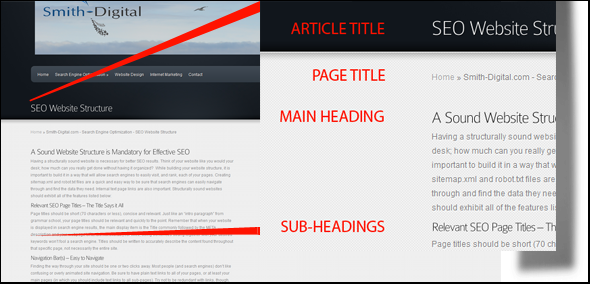A Sound Website Structure is Mandatory for Effective SEO
Having a structurally sound website is necessary for better SEO results. Think of your website like you would your desk; how much can you really get done without having it organized? While building your website structure, it is important to build it in a way that will allow search engines to easily visit, and rank, each of your pages. Creating sitemap.xml and robot.txt files are a quick and easy way to be sure that search engines can easily navigate through and find the data they need. Internal text page links are also important. Structurally sound websites should exhibit all of the features listed below:

Relevant SEO Page Titles – The Title Says it All
Page titles should be short (70 characters or less), concise and relevant. Just like an “intro paragraph” from grammar school, your page titles should be relevant and quickly to the point. Remember that when your website is displayed in search engine results, the main display item is the Title commonly followed by the META description and your webpage URL. Do not overdo your titles; using sentences strung together with your desired keywords won’t fool a search engine. Titles should be written to accurately describe the content found throughout that specific page, not necessarily the entire site.
Navigation Bar(s) – Easy to Navigate
Finding the way through your site should be one or two clicks away. Most people (and search engines) don’t like confusing or overly animated site navigation. Be sure to have plain text links to all of your pages, or at least your main pages (in which you should include text links to all sub-pages). Try not to be redundant with links, though, multiple links to the duplicate pages can count against you while search engines calculate your linking percentages. A main navigation, footer navigation to main pages and a sitemap page (or sitemap.xml) should be plenty. Make sure users of your website are able to see all of the hard work you have put into your website!
Organized Content for SEO – Headings, Paragraphs, and Styles
For SEO, each of your web pages should follow standard organization when it comes to your content. Proper use of headings (H1, H2, H3, etc.) and paragraphs is a must. Headings should briefly summarize the information contained in the paragraph(s) below. Headings should not be full sentences; short, concise headings will draw a users attention, and provide information to a search engines concerning page relevancy for its users’ keyword searches. You should also never use excessive breaks or open/close paragraphs for styling; styles should be defined in your stylesheet(s).css and the appropriate styles assigned to each heading or paragraph.
META Tags – Precursors for Search Engines
 As previously mentioned, META tags are important content that most users will never see. Hidden in the “head” area of your web page, the META tags include information about keywords, descriptions, and authors. Additional information includes instructions regarding suggested indexing options, FOLLOWing (or NOFOLLOWing) links contained within the page, and other related options. For the most part, be sure that every page has a META description tag. As stated above, this META description is the content used to describe your web page in a search engine’s results page. Also, be aware that changing these settings incorrectly can adversely effect the rankings of your pages, and so these types of changes should be handled by a responsible SEO.
As previously mentioned, META tags are important content that most users will never see. Hidden in the “head” area of your web page, the META tags include information about keywords, descriptions, and authors. Additional information includes instructions regarding suggested indexing options, FOLLOWing (or NOFOLLOWing) links contained within the page, and other related options. For the most part, be sure that every page has a META description tag. As stated above, this META description is the content used to describe your web page in a search engine’s results page. Also, be aware that changing these settings incorrectly can adversely effect the rankings of your pages, and so these types of changes should be handled by a responsible SEO.
SEO Friendly ALTs and Titles for Links and Images
Last, but not least, are ALT and Description tags/modifiers for links and images. As smart as search engines are, they are unable to necessarily “view” an image and understand what it contains. For this reason, there are tags that can be used to instruct a search engine of the content contained within the image. These tags, along with titles of links, can be very helpful when it comes to SEO. Make sure not to leave these items out.
